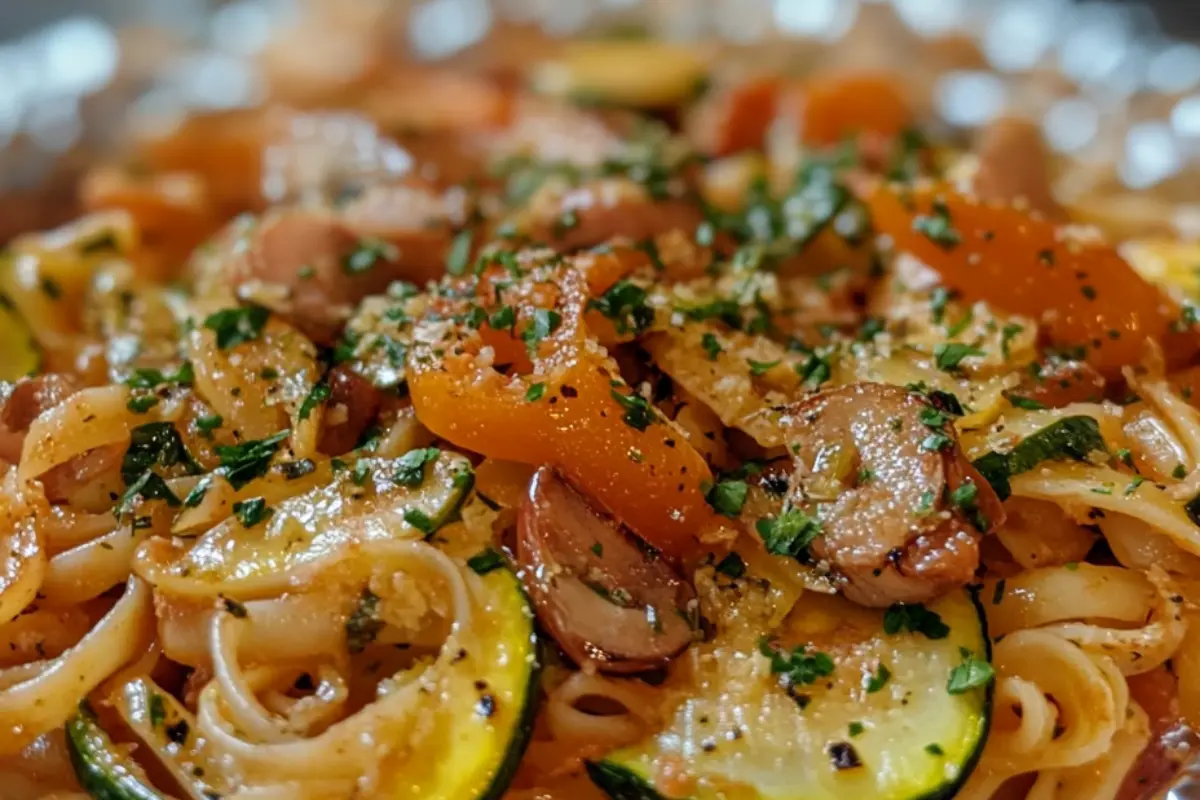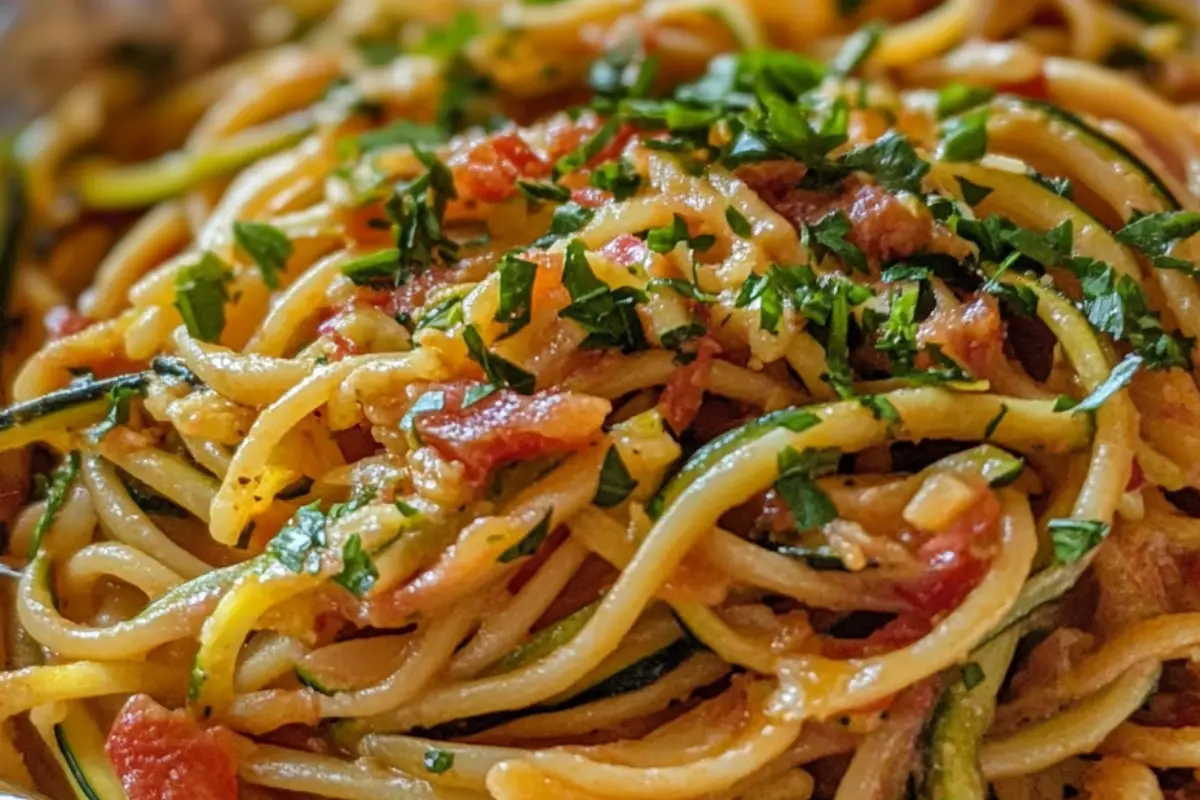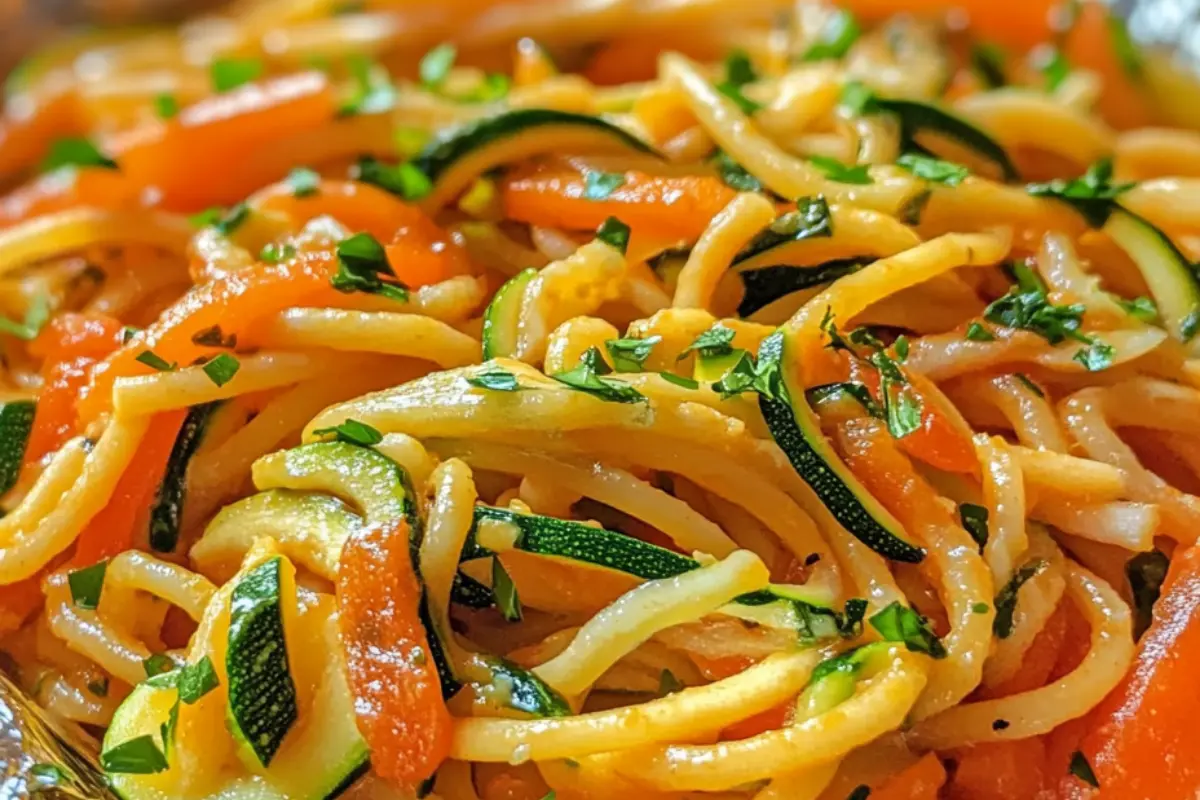
Why Choose Rhubarb Zucchini Pasta?
Introduction to Nutritional Benefits Rhubarb and zucchini are both low-calorie, nutrient-dense foods. Rhubarb is rich in antioxidants, vitamins K and C, and dietary fiber. Zucchini, on the other hand, is a great source of vitamins A and C, potassium, and magnesium. Altogether, they create a nutrition.
Comparison with Traditional Pasta Unlike traditional pasta, which is typically high in carbohydrates and low in nutrients, rhubarb zucchini pasta offers a low-carb alternative that’s brimming with vitamins and minerals. This makes it an ideal choice for those looking to reduce their carb intake or follow a gluten-free diet.
Preparing Rhubarb and Zucchini
Selecting Fresh Ingredients Choosing the right ingredients is crucial for making a delicious rhubarb zucchini pasta. Look for firm, bright green zucchini without any soft spots or blemishes. When selecting rhubarb, pick stalks that are crisp and vibrant in color. Avoid any that appear wilted or have a dull appearance.
Prepping Rhubarb and Zucchini Begin by washing the zucchini and rhubarb thoroughly under running water. For the zucchini, use a spiralizer to create noodles, or julienne them if you prefer a different texture. Rhubarb needs to be trimmed at both ends, then cut into small, bite-sized pieces. This ensures even cooking and a balanced flavor throughout the dish.
How to Make Rhubarb Zucchini Pasta
Introduction to the Recipe Making rhubarb zucchini pasta is simpler than you might think. With a few fresh ingredients and some basic kitchen tools, you can create a flavorful and healthy dish that’s sure to impress.
Ingredients
- 2 medium zucchinis, spiralized
- 1 cup rhubarb, chopped
- 2 cloves garlic, minced
- 1 small onion, finely chopped
- 1 cup cherry tomatoes, halved
- 1/4 cup fresh basil, chopped
- 1/4 cup grated Parmesan cheese (optional)
- 2 tablespoons olive oil
- Salt and pepper to taste
- 1 teaspoon red pepper flakes (optional)
Cooking Instructions
- Vegetables Must be Ready: Heat the olive oil in a large skillet on normal heat. Add the minced garlic and chopped onion, sautéing until fragrant and translucent, about 3-4 minutes.
- Cook the Rhubarb: Add the chopped rhubarb to the skillet. Cook for 5-7 minutes, stirring occasionally, until the rhubarb begins to soften.
- Add the Tomatoes: Stir in the cherry tomatoes and cook for another 2-3 minutes, allowing them to soften and release their juices.
- Mix in the Zucchini Noodles: Add the spiralized zucchini to the skillet, tossing gently to combine with the other ingredients. Cook for 3-4 minutes, until the zucchini noodles are tender but still slightly firm.
- Season and Serve: Sprinkle in the chopped basil, grated Parmesan cheese (if using), salt, pepper, and red pepper flakes. Toss everything together to ensure even seasoning. Serve immediately, garnished with additional basil and Parmesan if desired.
Tips for Making the Dish More Flavorful (Answering FAQ 1)
- Use fresh herbs like basil, parsley, or oregano to enhance the dish’s aroma and taste.
- Add a splash of lemon juice or zest for a bright, tangy flavor.
- Experiment with different cheeses, such as feta or goat cheese, for a creamy texture and richer taste.
Can Zucchini Be a Substitute for Regular Pasta?
Introduction to Zucchini as a Pasta Substitute Zucchini noodles, often referred to as “zoodles,” have become a popular alternative to traditional pasta. They offer a low-carb, gluten-free option that can be easily incorporated into various dishes.
Versatility of Zucchini Noodles Zucchini noodles are incredibly versatile. They can be used in almost any pasta dish, from classic spaghetti with marinara sauce to more exotic recipes like zucchini pad thai. Their mild flavor allows them to absorb and complement the sauces and seasonings used in the dish.
Benefits of Using Zucchini Over Traditional Pasta
- Low in Carbohydrates: Traditional pasta is high in carbs, which can be a concern for those monitoring their carbohydrate intake. Zucchini noodles provide a low-carb alternative, making them suitable for keto and other low-carb diets.
- Gluten-Free: For individuals with gluten sensitivities or celiac disease, zucchini noodles are a naturally gluten-free option that can replace wheat-based pasta.
- Nutrient-Dense: Zucchini is packed with vitamins A and C, potassium, and fiber, providing essential nutrients that are often lacking in traditional pasta.
Conclusion By substituting regular pasta with zucchini noodles, you can enjoy a healthier, lighter meal without sacrificing flavor or texture. This makes zucchini an excellent choice for anyone looking to enhance their diet with more vegetables and fewer carbs.
Popular Zucchini Pasta Recipes
Introduction to Zucchini Pasta Recipes Zucchini pasta can be transformed into a variety of delicious dishes. Here are some popular recipes that highlight the versatility of zucchini noodles.
Recipe 1: Classic Zucchini Noodles
Ingredients:
- 2 medium zucchinis, spiralized
- 2 cloves garlic, minced
- 1 tablespoon olive oil
- Salt and pepper to taste
- Grated Parmesan cheese (optional)
Instructions:
- Heat olive oil in a skillet on normal heat.
- Add garlic and sauté until fragrant.
- Toss in the zucchini noodles and cook for 3-4 minutes, until tender.
- Season with salt and pepper, and top with Parmesan cheese if desired.
Recipe 2: Zucchini Pasta with Pesto
Ingredients:
- 2 medium zucchinis, spiralized
- 1/2 cup pesto sauce
- 1/4 cup cherry tomatoes, halved
- 2 tablespoons pine nuts, toasted
- Salt and pepper to taste
Instructions:
- Toss zucchini noodles with pesto sauce in a large bowl.
- Add cherry tomatoes and pine nuts, mixing gently.
- Add salt and pepper to taste, and serve after.
Recipe 3: Zucchini Alfredo Pasta
Ingredients:
- 2 medium zucchinis, spiralized
- 1/2 cup heavy cream
- 1/4 cup grated Parmesan cheese
- 1 tablespoon butter
- 1 clove garlic, minced
- Salt and pepper to taste
Instructions:
- In a saucepan, melt butter on normal heat. Add garlic and sauté until fragrant.
- Stir in heavy cream and bring to a simmer.
- Add Parmesan cheese, stirring until melted and smooth.
- Toss in the zucchini noodles, cooking for 2-3 minutes until coated and heated through.
- Add salt and pepper, and serve after.
Health Benefits of Rhubarb and Zucchini Pasta
Introduction to Health Benefits Incorporating rhubarb zucchini pasta into your diet can offer a range of health benefits due to the nutrient profiles of both rhubarb and zucchini. This dish not only tastes great but also supports a healthy lifestyle.
Nutritional Profile of Rhubarb Rhubarb is a unique vegetable known for its tart flavor and vibrant color. It’s packed with essential nutrients, including:
- Vitamins: Rhubarb is an excellent source of vitamins K and C. Vitamin K is essential for bone health and blood clotting, while vitamin C boosts the immune system and acts as an antioxidant.
- Fiber: High in dietary fiber, rhubarb aids in digestion and can help maintain healthy cholesterol levels.
- Antioxidants: Rhubarb contains anthocyanins, which have been shown to reduce inflammation and protect against chronic diseases.
Nutritional Profile of Zucchini Zucchini, often considered a summer squash, is low in calories but rich in essential nutrients:
- Vitamins: Zucchini is a great source of vitamins A and C. Vitamin A supports vision and skin health, while vitamin C helps with immune function and collagen production.
- Minerals: It provides potassium, which is crucial for heart health and maintaining proper muscle function.
- Hydration: With a high water content, zucchini helps keep you hydrated and can contribute to a feeling of fullness, aiding in weight management.
Combined Health Benefits When combined in a dish like rhubarb zucchini pasta, these vegetables offer a powerful nutritional punch. This meal is low in calories and carbohydrates, making it an ideal choice for those looking to manage their weight or maintain a healthy diet. The high fiber content promotes good digestion, while the vitamins and minerals support overall health and well-being.
Tips for Enhancing the Flavor of Zucchini Pasta
Introduction to Flavor Enhancement Zucchini pasta, while nutritious and versatile, can sometimes benefit from a few flavor-boosting techniques. Here are some tips to ensure your rhubarb zucchini pasta is both delicious and memorable.
Use Fresh Herbs and Spices Fresh herbs such as basil, parsley, cilantro, and oregano can significantly elevate the flavor of zucchini pasta. Add these herbs towards the end of cooking to retain their vibrant taste. Spices like red pepper flakes, garlic powder, and smoked paprika can also add depth and a hint of spice.
Incorporate Aromatics Aromatics like garlic, onions, and shallots are essential for building a flavorful base. Sauté these ingredients at the beginning of your cooking process to release their flavors and infuse the dish with a rich aroma.
Add a Tangy Element To brighten the dish, consider adding a tangy element. A splash of lemon juice, a dash of balsamic vinegar, or a spoonful of capers can enhance the overall taste and provide a delightful contrast to the mild flavor of zucchini.
Experiment with Cheeses Cheese can add a creamy texture and savory flavor to zucchini pasta. Parmesan, feta, goat cheese, and ricotta are excellent options. Sprinkle cheese on top just before serving or mix it into the pasta while it’s still warm to allow it to melt slightly.
Try Different Sauces The sauce can make or break a pasta dish. For zucchini pasta, try experimenting with different types of sauces. Pesto, marinara, Alfredo, and garlic butter sauces all work wonderfully with zucchini noodles. Each sauce offers a unique flavor profile that can complement the dish in various ways.
Incorporate Nuts and Seeds Adding toasted nuts or seeds, such as pine nuts, almonds, or sunflower seeds, can provide a crunchy texture and a nutty flavor. This not only adds to the taste but also boost nutrition.
Frequently Asked Questions
Q1: How can I make zucchini pasta more flavorful? Enhancing the flavor of zucchini pasta involves using fresh herbs, aromatics like garlic and onions, tangy elements like lemon juice or vinegar, different cheeses, and experimenting with various sauces. Adding nuts and seeds can also provide a crunchy texture and additional flavor.
Q2: Can zucchini be a substitute for regular pasta? Yes, zucchini can be an excellent substitute for regular pasta. It’s low in carbohydrates, gluten-free, and nutrient-dense, making it suitable for those on low-carb or gluten-free diets. Zucchini noodles are versatile and can be used in a variety of pasta dishes.
Q3: What are some popular zucchini pasta recipes? Popular zucchini pasta recipes include:
- Classic zucchini noodles with garlic and Parmesan
- Zucchini pasta with pesto, cherry tomatoes, and pine nuts
- Zucchini Alfredo pasta with a creamy sauce
Q4: What are the health benefits of rhubarb and zucchini pasta? Rhubarb zucchini pasta is low in calories and carbohydrates while being rich in vitamins, minerals, and antioxidants. Rhubarb provides vitamins K and C, fiber, and antioxidants, while zucchini offers vitamins A and C, potassium, and hydration. Altogether, they adds up overall health and well-being.
Conclusion
Recap of Key Points Rhubarb zucchini pasta is a nutritious and delicious alternative to traditional pasta. It’s low in calories and carbohydrates, making it a great choice for those on low-carb or gluten-free diets. Both rhubarb and zucchini offer a wealth of vitamins, minerals, and antioxidants that contribute to overall health and well-being.
Encouragement to Try the Recipe By following the simple recipes and flavor-enhancing tips provided, you can create a variety of tasty dishes that are sure to impress. Whether you’re looking to reduce your carb intake or simply enjoy more vegetables, rhubarb zucchini pasta is a fantastic option.
Engagement Question Have you tried making rhubarb zucchini pasta before? What are your favorite tips and recipes? Share your experiences in the comments below!





